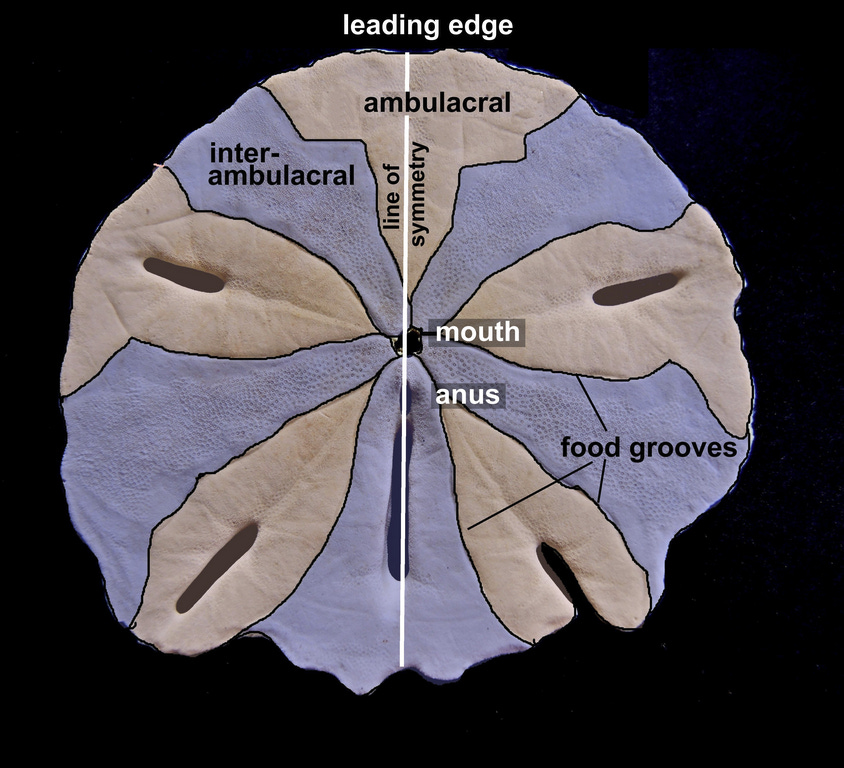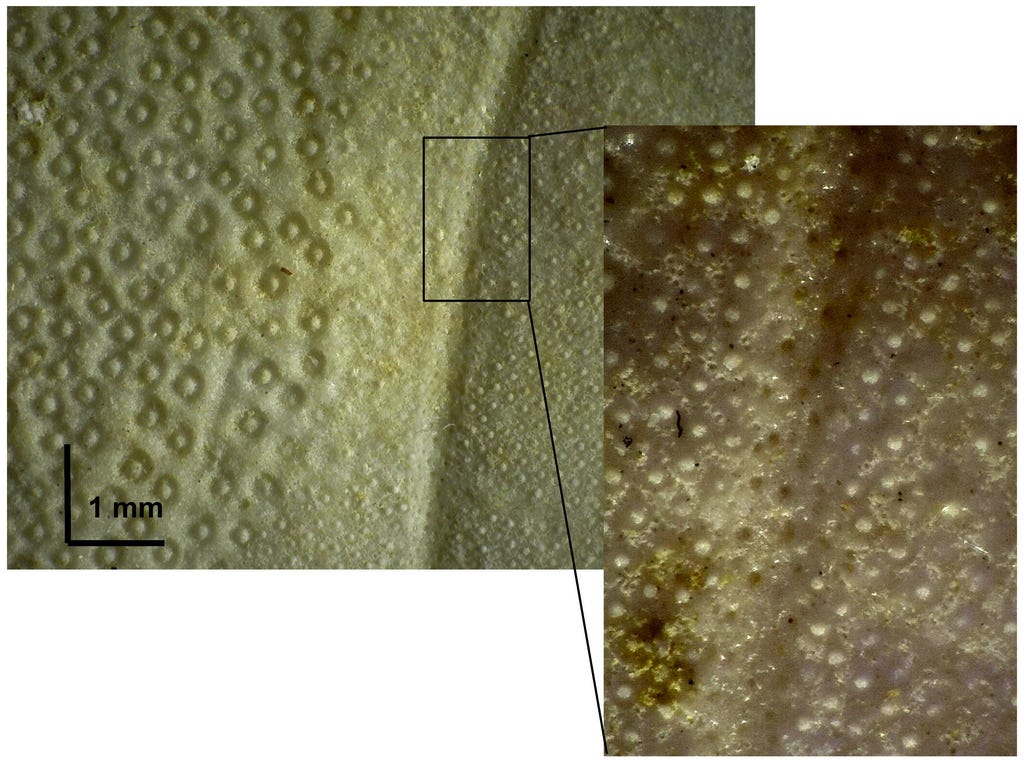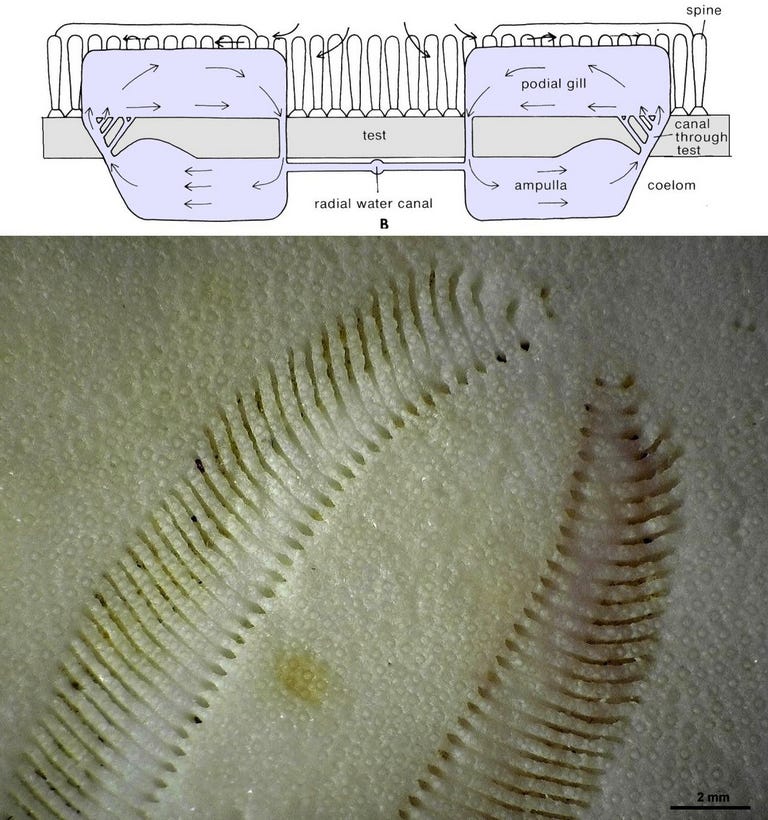If you have ever walked on a beach and found sand dollars, my Found Objects for this essay, maybe you knew that these are the earthly remains of an animal, an echinoderm. Perhaps you also knew that the living animals burrowed in the sandy bottom off the beach. But chances are slim that you knew that the living animals have a strange way of making a living. So, a close and sciency inspection of my Found Objects seems justified and will probably reveal things you never thought to ask. Chances are also good that you will marvel at these weird creatures before you paint them gold and hang them on your Christmas tree.
If you were asked to design an animal, I doubt you would come up with anything resembling an echinoderm. A worm maybe, or a salamander, or even perhaps a roly-poly, but not an echinoderm. Chances are, the animal you designed would be sort of tubular, a mouth at one end, an anus at the other, with at least a modest capacity to move about with legs, feet, undulations, contractions, slime trails, or other means. None of these traits suggest “echinoderm”, especially not “sand dollar.” There is a lot that is weird, peculiar, and unfamiliar about sand dollars, and thus worth closer consideration.
General body structure. Sand dollars and their relatives, the sea urchins are both Echinoids in the Phylum Echinodermata, the “spiny-skinned animals.” I described the strangeness of sea urchins in an earlier post, remarking that they look like a spiky planet as seen from space, or a strange robot built in the basement of an over-imaginative teenager. But sand dollars are even stranger, looking like a flying saucer decorated with flower petals. The sand dollar you find on the beach is only the rigid box of fused calcareous (limestone) ossicles (“little bones”) that once gave shape to a living sand dollar. In life, the “guts” of the animal are inside this box, while the outside is covered with a living, ciliated, spiny skin. With the right lighting, the outlines of the fused ossicles that make up the skeleton are visible, as in the image below in which the ossicles are accentuated by lines and shading. Three of the ten alternating sections are in clear view.

The sand dollar and the sea urchin are built of the same three body regions, but the sand dollar is like a sea urchin flattened in a tortilla press. Most of the visible body surface of the echinoids is the ambulacrum, which itself is made up of ten sections, five sections with rows of tube feet (more on that below) and five without feet, in alternation. The oral (down-facing, mouth-containing) and aboral (up-facing, anus containing) regions are tiny in echinoids as in the schematic below.
Body Symmetry. Most animals are bilaterally symmetrical, that is, there is a single plane that divides the animal into two mirror image halves, right and left. Echinoderms, however, appear to be radially symmetrical, meaning that any plane passing through the polar axis divides the animal into mirror images, but there is an infinite number of these. Ancestral echinoderms were indeed radially symmetrical, or nearly so, but as they evolved greater mobility, they trended toward bilateral symmetry.
A close look at the whole oral (down-facing) surface (color coded in the image below) shows clearly that the sand dollar is not truly radially symmetrical, for there is only one plane that divides the animal into two mirror image halves. In addition, the interambulacral section at 6 o’clock has a lunate slot with the anus at its inner end, accentuating that it is effectively bilaterally symmetrical, just like you and me.

Spines and their functions. The entire surface of echinoids is provided with bumps that articulated spines of multiple sizes and motility. The function of the spines depends on their size and location. In place of the large and small sea urchin spines that range from needle-sharp to spade or pencil shape, those of the sand dollars are all short and abundant as hair. After it dies, the spines fall off, revealing sockets of two types, large or small, their frequency depending on their location.
In sand dollars, the small spines on the aboral (up-facing) side are as dense as fur, but on the oral (down-facing) surface, large, movable spines predominate on the inter-ambulacral regions (Wikipedia), allowing the animal to creep along and to bury itself. This means that there must be some kind of coordination among these long spines so that they act like thousands of tiny legs that move the sand dollar in a forward direction. It is hard to picture how such coordination among thousands of spines might be brought about. What sort of neural system might be involved, and what sort of stimulus might be transmitted, and in what pattern?
The movable spines allow the animal to bury itself (Wikipedia) in the sand where they often occur in large numbers. Movement is directional, not random, and is toward the ambulacral section that lacks a slot. This slot-less section is the leading-edge during movement and effectively acts like a head. Having a “head” (i.e. a part that consistently meets the environment first as the animal moves) is strongly associated with the evolution of bilateral symmetry.
Tube feet and the water vascular system: Tube feet are a peculiar feature of the echinoderms in general and are variously involved in moving, holding, and gas exchange. Tube feet are essentially tubular extensions of the body cavity through rows of holes in the body wall in the ambulacral sections. They are operated by inflating or deflating them with water from the body cavity. The tube foot system plus the internal cavity is the sand dollar’s circulatory system and is called the water vascular system. But instead of blood to transport gases and metabolites, sand dollars have gone their own way and use filtered seawater. The site of this exchange is the porous aboral ossicle (called the madreporite) that filters water through sieve-like holes (below, right). A gonopore and an ocular pore can also be seen in the right image, but those are other stories.

The water enters a canal that forms a ring around the oral region, and gives rise to five ambulacral radial canals that inflate or deflate the tube feet (aka podia). The function of the tube feet is highly variable across the echinoderms, but in sand dollars, they are modified for two separate functions: feeding and gas exchange.
Feeding. In keeping with its other strange attributes, by most measures, feeding is bizarre. The ten shallow indentations in the oral surface of the test are food grooves (see earlier image of oral surface) in which short tube feet and cilia push water and food particles toward the central mouth. On both sides of each groove, arrays of short, movable spines help kick the food particles along the groove to create a stream of digestible (one hopes) particles picked up from the sand, essentially bits of organic detritus and organic-coated sand grains. These enter the mouth to be digested, and the waste ejected via the anus, which is, oddly, adjacent to the mouth. Oh well…

Gas exchange. Parts of the tube-foot system are the highly modified and conspicuous, star-shaped “petaloids.” These are specialized for gas exchange. Each petaloid tube foot is flattened and greatly widened into a leaf shape, with a canal through the test at each end of the flattened tube foot. Water from the radial canal circulates through the tube foot, allowing gases to diffuse between the water vascular system and the surrounding seawater. In the photo below, the perforations through the test are visible at each end of each gill slot . These “podial gills” demonstrate one of the constants in all gas exchange systems: the great increase of surface area across which gas exchanges take place. For example, the gas exchange surface of the human lung is about 75 m2, equivalent to a square 25 feet on a side.

These then are a few of the features revealed by close inspection of my Found Objects and are examples of what makes echinoderms in general, and sand dollars in particular such strange and interesting animals. None of our familiar animals (vertebrates, arthropods, mollusks, annelids) prepare us for the echinoderms. Yet, counter-intuitively, echinoderms are more closely related to us than to those arthropods, mollusks, and annelids. The two major lines of animal evolution are defined by fundamental differences in how their body arises during embryonic and larval development, including the nature of early cell divisions in the embryo, the formation of the mouth and anus, and of the body cavity. These traits diverged at the very dawn of animal evolution, and their conditions and several others define the lines of descent of the arthropods, molluscs, and annelids on the one hand, and the echinoderms and vertebrates on the other. As vertebrates, we are thus linked more closely to the echinoderms than to the other phyla. Somewhere in the very dim and distant past, probably before animals began to leave fossils behind, the sand dollar shared a common daddy (or mommy) with you and me.






Great essay, and awesome graphics. Crinoids are about the only creature stranger than echinoids and must have been the inspiration for some H.P. Lovecraft stories. I owe you one on sea cucumbers.
Here’s another perspective on the sand dollar:
https://www.ebay.com/itm/297244154667
Years ago, my husband’s parents used to sell these postcards in their rock shop for 10 cents apiece. I’ve read that the little “doves” that are found inside the shell are the creature’s teeth.